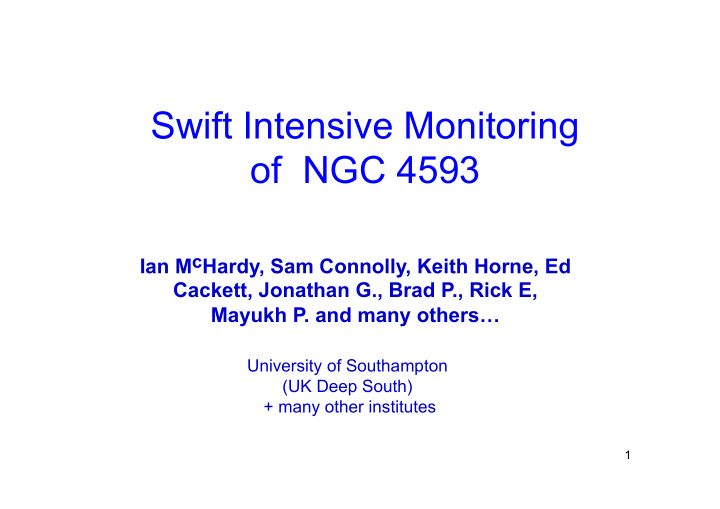



Swift Intensive Monitoring of NGC 4593 Ian M c Hardy, Sam Connolly, Keith Horne, Ed Cackett, Jonathan G., Brad P., Rick E, Mayukh P. and many others … University of Southampton (UK Deep South) + many other institutes 1
2 NGC4593 Swift (McHardy et al, in prep )
Southampton Lags relative to UVW2 Lags from Javelin Centroid lags from (Zu+11, 13) FR/RSS method (Peterson+98) Thin line with faint turquoise dots is the Shakura-Sunyaev model prediction 3
Southampton Model Swift UVOT Impulse Responses for NGC4593 6 UVOT bands uvw2 – blue V - green/yellow Rg/c =40s Seconds 10 100 1000 Rg Parameters: M=7.6e6, mdot=8.1%, ionising Lx from BAT extrapolation (3e43), Albedo=0.8, Rin=6Rg, Height_xray=6 Rg, inclination=45 Peak lag is ~ 1/3 of half-light lag. Half-light corresponds better to simulations. E.g. X-ray/UVW2 50% response time (plot above) is 0.096d. c.f. Measured lag between X-ray and simulated UVW2 is 0.13d (centroid) or 0.076d (peak) 4
Southampton Simulated and observed UVW2 – NGC 4593 Simulated UVW2 – black: observed UVW2 – red Lag reduces with boxcar filtering With 5d boxcar filtering Lag = 0.133 +/- 0.05 (centroid) Observed lags model (FR/RSS ) by 0.55 +/- 0.1 (centroid – peak gives lower value) With 5d boxcar filter of OBSERVED X-rays vs W2, lag is 0.26+/-0.07d (FR/RSS centroid), so shorter than unfiltered, but not quite as short as model 5
Southampton NGC4593 XMM PN-OM lag ie 0.38d (W1) => 0.28d (W2) Identical lag measurement to Swift (McH+, in prep). See also XMM PN-OM lags on NGC4395, Only one UV/optical band but easy to make. McHardy et al, 2016. 6
Memecho fit by Keith Horne Here the X-rays are a good driver of the variability in other bands. The response functions consist of a peak at short timescales (accretion disc) and an extended tail (surrounding gas). This analysis is completely consistent with the simple boxcar filtering and accretion disc modelling. 7
Southampton Measured / Expected lags for different AGN UVW2 to V band X-ray to UVW2 4151 – Edelson+17 4593 5548 – Edelson+15 4395 – McH+16 4151 4593 4151 5548 5548 4395 4395 Broadly similar Different and miles away from SS disc theory and not too far from SS disc theory NGC 4151 is the most absorbed 8
Southampton NGC4151 – Offset X-ray Lag (Edelson et al, 2017) UV-optical lags as in other AGN. But discontinuity to X-rays. Here X-rays are not a good driver of UV/optical emission. 9
Southampton NGC 5548 ( McHardy et al, 2014) Lag ∝ Wavelength 1.23 Model lags Then UVOT lags extrapolate to X-rays, Running 20d boxcar removed So X-rays reprocessed from disc can drive the UVOT here too. 10
Southampton Possible geometry for off-set X-ray lags Gardner +Done 2016 X-rays hit inner part of disc which re-radiates far-UV onto outer part. Extra X-ray/UV lag due to disc thermalisation timescale [not always needed] NOT NEEDED FOR NGC4593 ; MORE DISTANT GAS EXPLAINS LONG X-RAY/UVW2 LAG. 11
Southampton NGC 4593 Swift X-ray Spectrum 2-8 keV: power law, broad 6.4 keV iron line 0.3-70 keV. Power law, iron lines, and narrow ~7 keV line Small Galactic cold Nh, Two warm absorbers. (Mayukh Pahari) Similar to Brennemann+07 XMM, Except no ‘soft excess’ (from inner disc) 12
Southampton NGC 4593 X-ray Spectral Variability (none) 13
Southampton NGC 4593 UVOT Spectral Variability (none) V Constant component (host galaxy) Variable component W2 (disc) X(t) Wavelength (A) Useful input to energetics arguments 14
Southampton NGC 4593 Energetics Not done properly yet but … Lx (0.1-195 keV, from extrapolation of BAT) is 3e43 ergs/s For Hx=6Rg, Rin=6Rg, disc covering fraction from 10 to 300 Rg (approx uvot range) is 0.26. (Gas covering fraction can be larger) So X-rays hitting disc are ~ 0.75e43 ergs/s Typically there is ~1mJy of observed variation in each UVOT band. At 35Mpc distance of NGC4593 that gives L=1.38e27 ergs/s/Hz. Bandwidth from 200nm to 600nm is 1e15Hz. So for assumed flat spectrum L(200-600nm) ~ 1.4e42 ergs/s Allowing for factors of a few extrapolation to shorter wavelengths, and some albedo, there is still enough X-ray illumination to power uvot with above geometry. (I think the more detailed disc model gives similar results.) 15
Southampton CONCLUSIONS In NGC4593 the X-rays are probably the direct driver of the UV/optical variations. There are at least 2 components to the reprocessing functions required to produce the the UVOT lightcurves from the X-rays: - a short lag component consistent with the accretion disc - a more complex longer lag (few days) component from surrounding material. The non-disc lag shows up particularly in the U-band with Balmer contiuum (see Ed’s talk, next). Of 4 AGN with reasonably measured X-ray/UV/optical lags, over a range of 100 in mass and 80 in accretion rate, the UVW2-V band lags are all much as expected from disc reprocessing. However the X-ray – UVW2 lags are longer, particularly for NGC4151, which is the most obscured. Scattering and absorption are probably important.
Recommend
More recommend